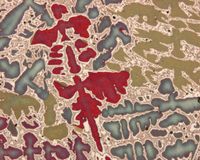
Photo from wikipedia
Common “glanded” (Gd) cottonseeds contain the toxic compound gossypol that restricts human consumption of the derived products. The “glandless” (Gl) cottonseeds of a new cotton variety, in contrast, show a… Click to show full abstract
Common “glanded” (Gd) cottonseeds contain the toxic compound gossypol that restricts human consumption of the derived products. The “glandless” (Gl) cottonseeds of a new cotton variety, in contrast, show a trace gossypol content, indicating the great potential of cottonseed for agro-food applications. This work comparatively evaluated the chemical composition and thermogravimetric behaviors of the two types of cottonseed kernels. In contrast to the high gossypol content (3.75 g kg−1) observed in Gd kernels, the gossypol level detected in Gl kernels was only 0.06 g kg−1, meeting the FDA’s criteria as human food. While the gossypol gland dots in Gd kernels were visually observed, scanning electron microcopy was not able to distinguish the microstructural difference between ground Gd and Gl samples. Chemical analysis and Fourier transform infrared (FTIR) spectroscopy showed that Gl kernels and Gd kernels had similar chemical components and mineral contents, but the former was slightly higher in protein, starch, and phosphorus contents. Thermogravimetric (TG) processes of both kernels and their residues after hexane and ethanol extraction were based on three stages of drying, de-volatilization, and char formation. TG-FTIR analysis revealed apparent spectral differences between Gd and Gl samples, as well as between raw and extracted cottonseed kernel samples, indicating that some components in Gd kernels were more susceptible to thermal decomposition than Gl kernels. The TG and TG-FTIR observations suggested that the Gl kernels could be heat treated (e.g., frying and roasting) at an optimal temperature of 140–150 °C for food applications. On the other hand, optimal pyrolysis temperatures would be much higher (350–500 °C) for Gd cottonseed and its defatted residues for non-food bio-oil and biochar production. The findings from this research enhance the potential utilization of Gd and Gl cottonseed kernels for food applications.
Journal Title: Molecules
Year Published: 2022
Link to full text (if available)
Share on Social Media: Sign Up to like & get
recommendations!